► Exclusive access to Singer Vehicle Design
► Update and upgrade classic Porsche 911s
► Expect it to take 18 months and cost $600k
Like all of humanity’s really great ideas – the wheel, powered flight, Instagram – LA-based Singer Vehicle Design ostensibly offers something very simple: the restoration and outwardly restrained modification of your old 964 Porsche 911. Some clients supply a tired car, leave a deposit and patiently await the finished product. Singer can help others locate the required blank canvas.
That Singer isn’t fussy about the state of the incoming cars (‘Most of them leave a snake’s trail of oil on the workshop floor as they arrive, but we don’t care so long as the body’s straight,’ smiles Singer’s Tim Gregorio) is one clue as to the magnitude of the work that will be lavished upon them.
Another is the patience required on the part of the client. Right now, with 72 commissions in the order book, you’re looking at an 18-month wait, of which 10 months is simply awaiting your turn. The process, from stripped shell to extensive pre-delivery testing and sign-off, is eight months. And yet another clue? A fee for the work alone of some $600,000.
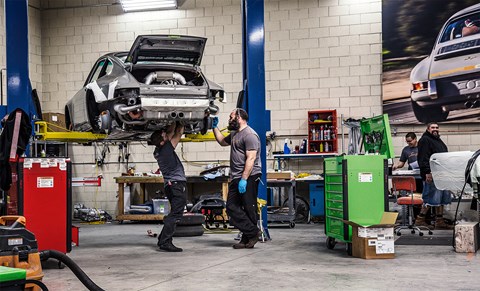
So while cars are delivered back from baggy oblivion through the application of money, effort, art, craft and love, so granular and obsessive is Singer’s work, so thorough and holistic the engineering, and so breathtakingly, heart-rendingly beautiful the finished product that the term restoration just doesn’t feel big enough. If these cars are restorations then Apollo 17’s haunting Hasselblad image of this planet – the first to capture it whole and to put it in context as a delicate blue, green and white marble of life adrift in a cold, silent infinity – is just a photo.
‘To me the idea was obvious, and I’m someone who’s never sure about anything,’ explains Singer’s British-born driving force Rob Dickinson, cousin of Iron Maiden frontman Bruce and a musician himself. ‘I wanted to present to the world a vision of an ultimate air-cooled 911. I’d been immersed in the Porsche community long enough to know intimately the desires of people like us – people who love these crazy old cars – and I was convinced that if I didn’t do what I had in mind, someone else would.’
A lifelong fan of the marque and a member of the R Gruppe, an influential club of Porsche enthusiasts formed in LA in the early 2000s, it becomes clear very quickly that Rob gets old 911s. It’s also evident that Rob is completely uninterested in spreadsheets, profit margins and conventional business models.
‘I had the lofty idea that the car would be so awesome that it didn’t matter how much it had to cost,’ he laughs. ‘That was the kind of blind faith that I had when we were working on the first prototype in 2008. I spent huge amounts of someone else’s money with no sleepless nights, building a conceptwith no idea how much it would cost to replicate. Price wasn’t in the blueprint. The car had to be a blue-sky “what if?” With no limits, how great could the air-cooled 911 be?’
Singer’s methodology has evolved since then into a streamlined process of ruthless optimisation, one that offers the client huge scope for personalisation while also staying true to Rob’s original blueprint for an über 911: the air-cooled Porsche as you think you remember it, as it would be were it possible to drive one without the Vaseline-smeared lens of time and nostalgia and benevolent forgiveness slipping away the moment you slot first and drive away.
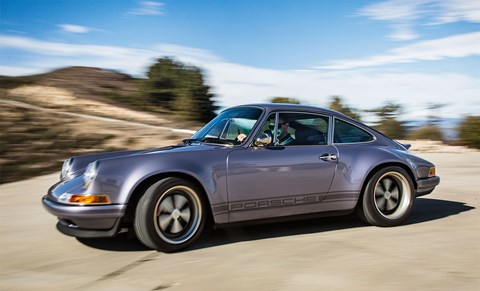
Stripped shells are reinforced, seam-welded for strength (as 964 RS bodies were) and finished in an anti-corrosion epoxy. If the donor car’s a coupe with a sunroof, owners can specify a carbonfibre panel with which to close the unwanted aperture.
Further carbon panels, each impossibly light (in total some 200kg of weight is removed from the car), rigid and neatly finished thanks to Singer’s relationship with composite specialists Aria, include the bonnet, complete with over-sized fuel-filler aperture, front bumper, engine cover and wings.
You can’t miss the wings. Their supine curves elegantly span the void between the 964’s standard doors and the outer edges of Singer’s trademark wheels; three-piece Fuchs-inspired objects of wonder measuring 17 inches in diameter, nine inches wide at the front and a filthy 11 inches across at the rear. The wings’ outlandish proportions are somehow almost conservative in isolation but impossibly voluptuous next to a standard 964 shell.
On goes an array of dazzling exterior detailing: bespoke headlights comprising Singer’s own lens design with Hella xenon hardware; sidelight and indicator units designed in-house around a resin casting that’s nickel-plated and fitted to the body with tolerances that are more horological than automotive; new glazing, the front quarter lights toughened and drilled to take a hole for Singer’s own bullet-style stalk-adjusted mirrors; bespoke engine cover hinges, their spring-assistance adjusted to suit the lighter, carbon cover.
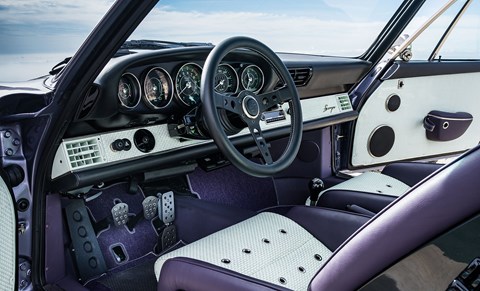
To these eyes the body blurs eras, melding late-’80s metal with curves and motifs that evoke the ’70s 2.8 RSR and the ’60s 911R. Similarly the interior re-fit references 911 cockpits at least a decade older than the 964. As with the exterior, bewildering customisation potential is kept manageable by a blueprint, so while no two cars are the same, a couple of key choices provide the differentiation: Touring, Sport or carbonfibre Track Recaro seats; a leather-lined, carpeted or bare metal interior finish (the bare metal is actually body coloured panels over sound-proofing, to keep road noise and and gravel pinging muted and the flat-six’s racket centre-stage).
Most owners opt for Singer’s spectacular block-pattern weave of suede and leather for their trim. The rear rollcage is popular too, leather-wrapped of course, as are the seat grommets, in either brass or nickel. Choose between early or late-style gauges, brought back to life and custom finished by North Hollywood Speedometers, and how you want the space behind the front seats to feel (seats, a rollcage or neither) and you’re nearly there – Singer’s beloved Momo Prototipo wheel is a given.
But just as you’re thinking of dismissing all of this as a hugely expensive but ultimately superficial makeover, you catch sight of the suspension hardware, a no-compromise blend of Porsche parts, Singer components (control arms, strut top mounts, all the bushings) and the very best of the aftermarket, including KW adjustable shocks or big-money Öhlins TTX units. Brakes are 993-sourced, with Singer’s Big Brake upgrade comprising the meaty Brembos from the Turbo. Up front, an aluminium race-style bag fuel tank sits in a throne room of A-surface painted bodywork and luxurious, diamond-stitched marine leather.
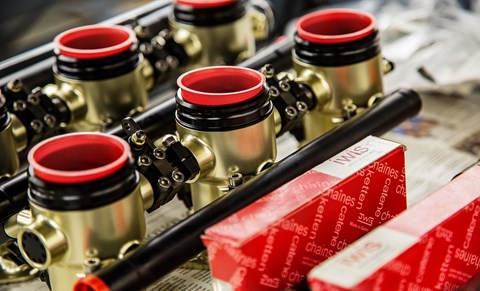
A vast oil cooler many times the size of the standard 964 cooler waits to be hooked up. Through the carcass of the car runs a military-grade wiring loom with the language skills to speak fluently to the Porsche ABS module, the AEM engine management and the car’s Motec brain. Through everything run the common threads of excellence without compromise and the pursuit, however painful, of parity between dynamic and aesthetic brilliance. It’s impossible to ponder the complexities involved for more than a few moments without feeling queasy.
‘We spent years sweating spring rates, damping rates, cambers and ride height,’ continues Rob. ‘I knew this stuff was vitally important from my time at Lotus. [Dickinson briefly held a design position at Hethel before pursuing hisfirst dream, to make rock ‘n’ roll music]. We wanted this car to be a triple set; it had to look great, be built like a Rolex and go down the road like a f**king weapon. It had to drive like no air-cooled car before it. The first two cars we restored were G-series 911s but it became clear that was a mistake. We needed a modern 911 platform if we were going to put so much power into the car.
‘That drove us to the 964, this fantastic hybrid of old-school 911 at the back and reasonably 20th century thinking at the front. We knew it had front geometry you could put good damping on, beautiful power steering and ABS, and that if we took weight out, optimised the engine and tweaked the brakes only good things could happen. A lot of our guys have come from 997 911s – we’re introducing them to this fabulous world of air-cooled Porsches – so we questioned the sense in offering them something with the whiff of an antique about it.’
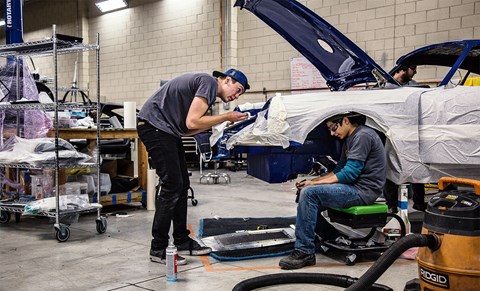
Each car’s heart is the work of long-established Sun Valley specialists Ed Pink Racing Engines. Born in the ’60s to supply competition V8s to California’s vibrant drag racing scene, Pink’s client base has changed with the times, even if the virtues of unholy power with complete reliability have never gone out of fashion. In the ’80s the company worked on its first Porsche engines.
‘Ed Pink Racing’s first work with Porsche was the BF Goodrich/Jim Busby 962s in IMSA GTP in the late-’80s,’ explains Pink’s general manager Frank Honsowetz. ‘Currently in the shop we’ve seven Singer engines, a ’73 RSR race car engine, a ’76 935 engine [its turbo the size a snoozing greyhound] and a 907 motor, in amongst probably 35 other projects. We have a nice relationship with Singer, who first came to us in 2014. The 4.0-litre engine came out of consultation with them: our ideas, their ideas, little improvements. Last year we delivered 26 engines back to them.’
The fit between Singer and Pink’s is heaven-sent. With ear-splitting noise, the oppressive fug of cutting fluid in the air and great drifts of swarf on every surface, most engine shops are like war zones. Pink’s is not like this. Immaculate, quiet and methodical, the workshops’ pristine benches perfectly mirror the quality of its completed builds.
Of the car’s original engine, only the case halves (inspected, crack-tested and tumbler de-burred for that just-so cosmetic finish) and the two cam carriers are re-used. Everything else is replaced. The cases are machined to take the bigger GT3 oil pump, the mating surfaces lapped for an oil-tight seal and the capacity bumped to 4.0 litres.
‘We do the 4.0-litre a little differently to the Porsche 4.0-litre,’ explains Honsowetz. ‘The rotating diameter of the crank assembly doesn’t clear the oil pump, so they make the pump smaller. We downsize the components instead, reducing weight and letting us hang onto the bigger oil pump.’
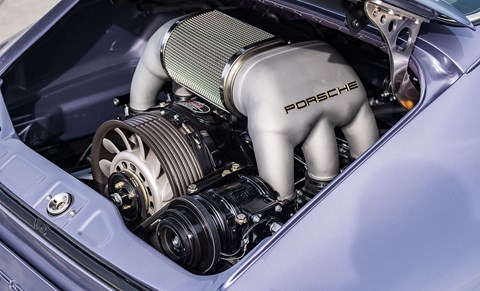
Specialists Mahle supply new cylinder liners and a race-style lightweight aluminium piston slick with their Grafal low-friction coating. Carillo con-rods ride on a machined-from-solid crankshaft designed to Pink’s specs. Beautiful Xtreme CNC-machined aluminium cylinder heads sport enormous steel valves (52.83mm on the exhaust side; 41.53mm on the inlet).
50mm Jenvey injector bodies supply the fuel/air mix, regulated by an AEM coil-per-plug electronic ignition and fuel-injection system. They’re fed by a part that embodies the top-drawer relationships at work behind these engines; a 997 911 GT3 manifold spotted by Pink’s at Porsche Motorsport, modified to fit the slimmer air-cooled engine, tested and, once validated, subjected to an extensive Singer cosmetic overhaul.
The end result is a masterpiece of a motor: 390bhp at 7300rpm, 315lb ft at 5900rpm and a six-figure dollar value. On power it sits between the latest (liquid-cooled and turbo-assisted) 911 Carrera and Carrera S. Ostensibly Singer also offers a 3.8 but funnily enough the 4.0-litre is the six of choice. ‘We thought the 4.0-litre would be 30% of the mix,’ laughs Frank. ‘It’s more like 90%.’ In fact Singer have had three cars back to swap their 3.8s for the 4.0-litre.
All of Singer’s previous restorations have been rear-wheel drive, but it’s a mark of the depth of the engineering talent within the company (a dedicated team of six, with Solidworks CAM capability, working under the Porsche-obsessed, motorsport-schooled technical director Chris Walrod) that when a client expressed an interest in all-wheel drive, Singer didn’t politely show him the door. Instead they pondered the challenge, considered the most desirable end result and then set to work using all of Porsche’s engineering back catalogue and the wealth of aerospace and automotive expertise in the Los Angeles area.
‘The drivetrain is based on the 993 all-wheel drive system,’ explains Singer’s production manager Jason Frahm. ‘It has the 993’s viscous coupling so the torque splits are straight-up 993, and we went that way because we wanted a system that felt rear-wheel drive in most scenarios. The 964 four-wheel-drive system is so much more complicated and intrusive – essentially Porsche was trying to do the 959 in a production car. There’s no toque-steer to speak of, just the feeling that you’re being pulled out of corners by the front of the car. It only comes out when you need it. It couldn’t have turned out better. We got lucky.’
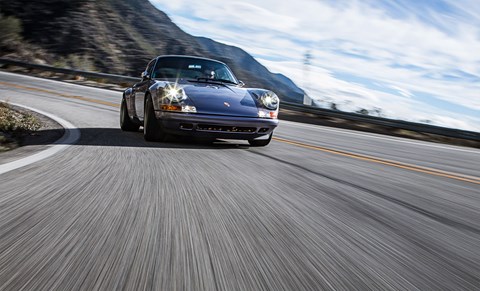
By rights the notion of jumping into this inaugural all-wheel-drive car, rolling into the loose-limbed, anything-goes mayhem of multi-lane LA traffic and then letting rip in a just-minted restoration should be terrifying. Its value is around the $600,000 mark (plus the cost of the 964) but there is no other 911 like it and its patient owner, who wishes to remain anonymous, has patiently crossed off 730 days. Being made to wait another two years wouldn’t go down well.
And then of course there’s the liberating paucity of driver assists beyond the ABS brakes, just that near-400bhp buzzsaw of a motor sat out beyond the back axle. ‘Remember when sports cars were just a little bit dangerous?’ smiles chief test pilot Séamus Taffe as the engine warms in the light of a perfect Californian sunrise.
But the fear never comes – the thrilling, visceral joy in my guts gives it no room to take hold. The car certainly has the potential to be dangerous, with its outlandish ability to gather speed (the rear-wheel-drive 4.0-litre has recorded 0-60mph in 3.3 seconds, 0-100mph in 8.2 and 176mph flat-out) and wacky weight distribution – but from the moment I snuggle into the Recaro seat, locate the gorgeous floor-hinged pedals and, with only slightly clammy palms, grasp the 917-style Momo wheel, there’s only a calm sense of control.
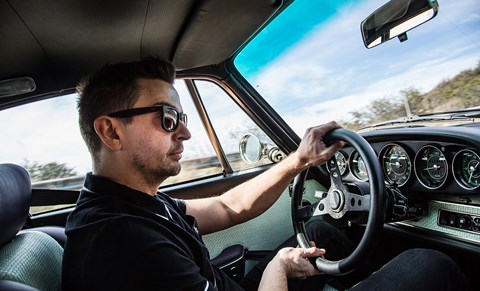
Get moving and within moments you’re intimate with the power curve and the way the car responds to it. Before the first stop sign you have muscle memory for the light, fast gearshift. And via your hands the steering exhaustively details every nuance of the car’s relationship with the road and the front tyres’ ability to follow your intended course. At last cool, static cars and so much theory are giving way to raging, heat-soaked kinetics on the serpentine curves of the Angeles National Forest, and I can’t stop laughing. Fortunately Tim Gregorio, on hand to stop me making for a new life in Mexico with a very conspicuous German sports car, is used to this kind of thing.
As gridded urban traffic gives way to curves and space, the 911’s throttle pedal goes to the end of its travel. The engine immediately charges the car’s apparently inconsequential mass with energy, punting it up the road like driftwood in roiling surf. The thud in the back is thuggish, insistent and long-lived, the flat-six shredding from low revs to 7200rpm in one clean, endless body blow. There isn’t so much as a hint of a hiccup, and this on the angriest of the three available camshafts.
The tarmac is soon twisting into gorgeous little knots. The way the car rides them is difficult to describe: animated, loose and organic but at the same time precise, predictable and with an eerie sense of control. The lines of communication, from every part of the car to each of your senses, never drop quiet. There’s no other explanation for the confidence to immediately begin running into corners hard on the tireless brake pedal, letting 911 physics do the turning and exploring the all-wheel-drive system’s towering corner-exit grip.
Just as you sense the vast sticky rear Michelins are thinking about blurring into over-rotation, so the front of the car seems to pull even tighter to your chosen line, like you’ve tramped on the power in a front-wheel-drive hot hatch with a really angry differential. The nose stays tight, the car rails round and you realise you could have brought that end-of-days engine to bear at least ten feet earlier. All the while the steering remains uncorrupted, engaging, bright.
In a layby overlooking the grubby, sun-drenched sprawl of LA far below, I pull in, fall out of the car and sit with its owner a while on cool, steel guard rail. He commissioned the restoration in January 2014 on the strength of a morning spent at the workshop and talking to the Singer team.
‘I loved their work but I wanted something you didn’t need to be Steve McQueen to drive fast in the rain. They’ve done an amazing job with the all-wheel drive. I knew the car would be nice but I honestly didn’t think it would be this good. It was finished last summer, so I took it for a drive up to Napa. I thought I’d do 150 miles a day because it’s an old car but I couldn’t stop driving. I did 500 miles per day and had to cancel three hotels. I just drove and drove, stopping only for fuel.’
The distilled essence of 911 will do that to you.
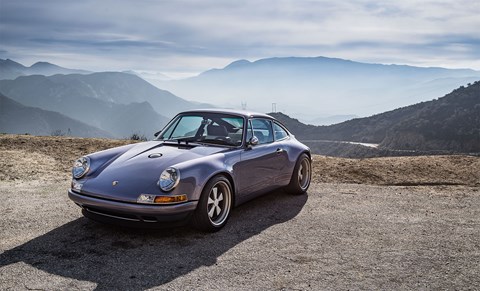
‘I have a dream…’ The Singer phenomenon, by Rob Dickinson
‘Everything we do is from the heart to celebrate Porsche and this crazy old rear-engined car they came up with. It’s meant to be authentic, to follow their design values. Hopefully we’re starting to resonate a little in Germany but that’s not for me to say. We have friends there, and we hope the relationship blossoms from private toleration into something more.
‘I first came to Southern California in the early ’90s with my band. I fell in love with the place. I moved here in 2003, built my hot-rod 911 and immersed myself in the area’s optimism, the car culture, the wisdom, the talent. This project couldn’t have happened anywhere else. There’s an amazing village industry supporting motorsport and aerospace engineering and car design; all the OEMs have design studios here. Everything we do is a product of California.
‘It’s been a monumental team effort, and we’ve attracted some really talented people. One of the reasons the car goes down the road so well is that we had a major ride and handling supremo from one of the big car companies offer his assistance. He happened to have a 964 and a ’72 911 so he was the perfect guy. Recently we did a book and I wanted to make sure we thanked everyone who’s been involved – there are about 4000 names in the back of that book.
‘We’re focused on the 964 for now but that doesn’t mean we couldn’t use the earlier monocoques – we’re looking into that. There’s also the sense that we’d love to celebrate other aspects of Porsche’s heritage. I’m sure people would love an optimised version of other cars Porsche has produced.
‘It’s something we didn’t predict but the relationship with the owners has become as important as the cars themselves. Clients are sent updates every two weeks. If something goes wrong we tell them about it. They realise we’re only charging this amount of money because we have to – nobody’s getting rich quick.’
The specs: Porsche 911 (964) 4.0-litre AWD, restored by Singer Vehicle Design
Price: $600k (work only)
Engine: 3940cc air-cooled flat-six, 390bhp @ 7300rpm, 315lb ft @ 5900rpm
Transmission: Six-speed manual, limited-slip differential, all-wheel drive
Suspension: Strut front, trailing arm rear, Öhlins TTX dampers
Performance: 3.6sec 0-60mph, 176mph (est)
Length/width/height: 4275/1753/1310mm
Weight/made from: 1310kg/steel and carbonfibre
On sale: Order now…
Rating: *****